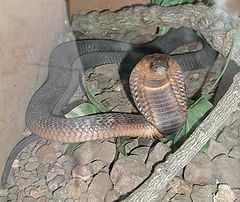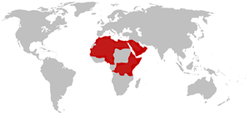- Egyptian cobra
-
Egyptian cobra 
Scientific classification Kingdom: Animalia Phylum: Chordata Class: Reptilia Order: Squamata Suborder: Serpentes Family: Elapidae Genus: Naja Species: N. haje Binomial name Naja haje
(Linnaeus, 1758)[1] Distribution of the Egyptian Cobra
Distribution of the Egyptian CobraSynonyms Coluber haje Linnaeus, 1758
Vipera haje Daudin, 1803
Naja haje Merrem, 1820The Egyptian cobra (Naja haje) is a species in the genus Naja found in Africa and the Arabian Peninsula. It is one of the largest Naja species in Africa.[citation needed]
Contents
Description
The Egyptian cobra may grow to between 5 and 8 feet (1.5 and 2.4 m) in length. The most recognizable characteristics of an Egyptian cobra are its head and hood. The head is large and depressed with a broad snout. The cobra's eyes are large with round pupils. The colour is variable, but most specimens are some shade of brown, often with lighter or darker mottling, and often a "tear-drop" mark below the eye. Specimens from northwestern Africa (Morocco, Western Sahara) are almost entirely black.
Habitat
The Egyptian cobra typically makes its home in dry to moist savanna and semi-desert regions with at least some water and vegetation (never in desert regions). The cobra may also be found in oases, agricultural grounds, rock crevices, hills with sparse vegetation, and grasslands.
Behavior
The Egyptian cobra is terrestrial and nocturnal in the wild, though in captivity they seem to tend towards diurnality.[2][dead link] It can, however, be seen basking in the sun at times in the early morning. It shows a preference for a permanent home in abandoned animal burrows, termite mounds or rock outcrops and the like, sometimes entering human habitations to hunt domestic fowl. It will generally attempt to escape when approached, at least for a few metres, but if threatened it assumes the typical upright posture with the hood expanded. This snake preys on small mammals, lizards, toads, and other snakes.
Venom
The venom of the Egyptian cobra is mainly neurotoxic,[3] the average venom yield is 175 to 300 mg in a single bite and the subcutaneous LD50 of this species is 1.15 mg/kg.[4][5] venom affects the nervous system, stopping the nerve signals from being transmitted to the muscles and at later stages stopping those transmitted to the heart and lungs as well, causing death due to complete respiratory failure. Envenomation causes local pain, severe swelling, bruising, blistering, necrosis and variable non-specific effects which may include headache, nausea, vomiting, abdominal pain, diarrhea, dizziness, collapse or convulsions along with possible moderate to severe flaccid paralysis. Unlike some other African cobras (for example the Red spitting cobra), this species does not spit venom.[6]
Taxonomy
The specific name haje is the transliteration of Arabic حية which is the word for snake or viper. The snouted cobra (Naja annulifera) and Anchieta's cobra (Naja anchietae) were formerly regarded as subspecies of Naja haje, but have since been shown to be distinct species.[7][8] The Arabian populations were long recognised as a separate subspecies, Naja haje arabica, and the black populations from Morocco sometimes as Naja haje legionis. A recent study[9] found that the Arabian cobra constitutes a separate species, Naja arabica, whereas the subspecies legionis was synonymised with N. haje. The same study also identified the West African savanna populations as a separate species and described it as Naja senegalensis.
Distribution
The Egyptian Cobra ranges across most of North Africa north of the Sahara, across the savannas of West Africa to the south of the Sahara, south to the Congo basin and east to Kenya and Tanzania, and in southern parts of the Arabian Peninsula.[10]
In zoos
The Egyptian Cobra can also be found in captivity at zoos both in and outside of the snake’s natural range. The Giza Zoo[11] and the San Diego Zoo[12] as well as the Virginia Aquarium in Virginia Beach, VA include the Egyptian Cobra in their reptile collection.
Bronx Zoo escape
On March 26, 2011, the Bronx Zoo informed the public that their reptile house was closed after a venomous adolescent Banded Egyptian cobra was discovered missing from its off-exhibit enclosure on March 25. The Cobra is actually a Banded Snouted cobra, N. annulifera, formerly considered conspecific to the Egyptian Cobra. Zoo officials were confident the missing cobra would be found in the building and not outside, since the Egyptian cobra is known to be uncomfortable in open areas.[13] The snake's metabolism would also have been impacted by the cold weather outdoors at that time in the Bronx. The cobra was found in a dark corner of the zoo's reptile house on March 31, 2011, in good health.[14]
Other cultures
In Ancient Egyptian culture and history
The Egyptian cobra was represented in Egyptian mythology by the cobra-headed goddess Meretseger. A stylised Egyptian Cobra — in the form of the uraeus representing the goddess Wadjet — was the symbol of sovereignty for the Pharaohs who incorporated it into their diadem. This iconography was continued through the period of Ptolemaic Egypt (305 BC-30 BC).
Most ancient sources say that Cleopatra and her two attendants committed suicide by being bitten by an aspis, which translates into English as "asp". The snake was reportedly smuggled into her room in a basket of figs. Plutarch wrote that she performed experiments on condemned prisoners and found aspis venom to be the most painless of all fatal poisons.[15] This "aspis" was probably Naja haje (the Egyptian cobra). However, the accounts of her apparent suicide have been questioned, since death from this snake's venom is relatively slow, and the snake is large, so it would be hard to conceal.[16]
As a pet
The Egyptian cobra garnered increased attention in Canada in the fall of 2006 when a pet cobra became loose and forced the evacuation of a house in Toronto[17] for more than six months when it was believed to have sought refuge in the home's walls. The owner was fined $17,000 and sentenced to jail.[18]
References
- ^ ITIS Standard Report Page: Naja haje
- ^ Egyptian Cobras
- ^ Naja haje haje (Egyptian cobra) venom.
- ^ LD50 Menu
- ^ LD50 (Dr. Bryan Grieg Fry)
- ^ Bogert, C.M. (1943) Dentitional phenomena in cobras and other elapids with notes on adaptive modifications of fangs. Bulletin of the American Museum of Natural History, 81, 285–360.
- ^ Broadley, D.G. (1995) The snouted cobra, Naja annulifera, a valid species in southern Africa. Journal of the Herpetological Association of Africa, 44, 26–32.
- ^ Broadley, D.G. & Wüster, W. (2004) A review of the southern African ‘non-spitting’ cobras (Serpentes: Elapidae: Naja). African Journal of Herpetology, 53, 101–122.
- ^ Trape, J.-F., L. Chirio, D.G. Broadley & W. Wüster (2009) Phylogeography and systematic revision of the Egyptian cobra (Serpentes: Elapidae: Naja haje) species complex, with the description of a new species from West Africa. Zootaxa 2236: 1-25.
- ^ Spawls, S. & Branch, B. (1995) The Dangerous Snakes of Africa. Blandford, London, UK
- ^ Giza Zoo – Egyptian Cobra, accessed March 29, 2011.
- ^ San Diego Zoo – Reptiles, accessed March 29, 2011
- ^ Kevin Dolak (27 March 2011). "Bronx Zoo Reptile House Closed After Poisonous Snake Goes Missing". ABC News. http://abcnews.go.com/US/poisonous-snake-missing-bronx-zoo/story?id=13233433. Retrieved 29 March 2011.
- ^ staff and wire (31 March 2011). "Missing Bronx Zoo cobra found, officials confirm". MSNBC. http://today.msnbc.msn.com/id/42362625/ns/today-today_pets_and_animals/. Retrieved 31 March 2011.
- ^ Plutarch Parallel Lives, "Life of Antony"
- ^ Richard Girling Cleopatra and the asp The Times November 28, 2004
- ^ CBC: Escaped venomous cobra in Toronto wanted dead or alive
- ^ CBC: Owner of deadly pet cobra jailed, fined $17,000
External links
Categories:- Elapidae by common name
- Reptiles of Morocco
- Venomous snakes
Wikimedia Foundation. 2010.
